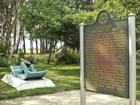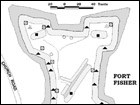Artifacts and historic sites that have survived from the War of 1812 will always be threatened by natural processes of destruction. It is the National Park Service's mission to care for these resources so that they will endure for future generations to experience and interpret for themselves. This is accomplished through a network of support and partnerships as well as the utilization of new and innovative preservation technologies.
-
Article 1: Planning: War of 1812 Preservation Study

Battlefield preservation enables current and future generations to better understand the connection between military conflicts and important social and political changes that occurred in American history. The National Park Service's American Battlefield Protection Program is committed to helping states and local communities preserve the most important battlefields for future generations. Read more
-
Article 2: Guidelines: Sustaining Battlefield Earthworks

Today, earthworks management is viewed as an evolving science that requires an integrated approach to natural and cultural resource management. Many parks in the public and private sectors employ a variety of techniques in an effort to expand the range of successful management practices. Read more
-
Article 3: Collections: Preserving Perishable Materials

A national treasure, the Star-Spangled Banner has been on view almost continuously since it came to the Smithsonian Institution in 1907. Despite receiving the best possible care, the flag, already timeworn, has deteriorated further from decades of exposure to light, pollution and temperature fluctuations. Read more
-
Article 4: Cemeteries: Maintaining the Graves of Fallen Heroes

20,000 Americans lost their lives in service to their country during the War of 1812. These brave souls are buried in cemeteries from Ohio to Alabama and east to Maryland. The more prominent cemeteries are preserved by local, state, and the federal governments. Smaller private and out-of-the way plots sometimes languish without care. The National Park Service is developing guidelines for all groups seeking support in preserving the resting places of America's fallen. Read more
-
Article 5: Archeology: Discovering Hidden 1812 History

The National Park Service and other agencies engage in archeology both on land and under water. Read more
-
Article 6: New Technologies: Advanced Mapping with GIS

One of the most useful and important management tools recently developed for the computer is the Geographic Information System (GIS), which can be used to store, sort, and recover geographic data. GIS can contain maps, images, and other information related to archaeological sites. Such a system can be a vital tool in historic lands preservation. Read more
